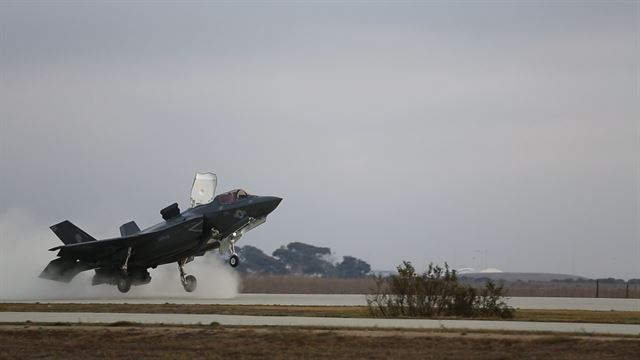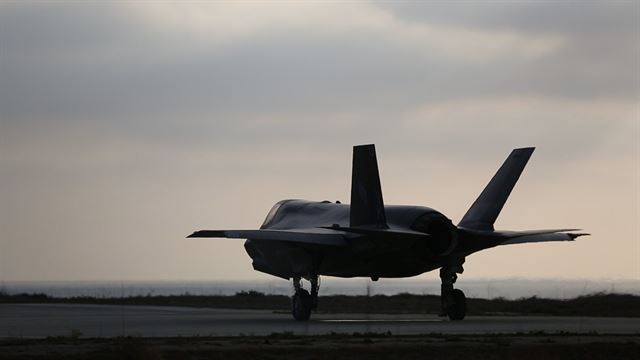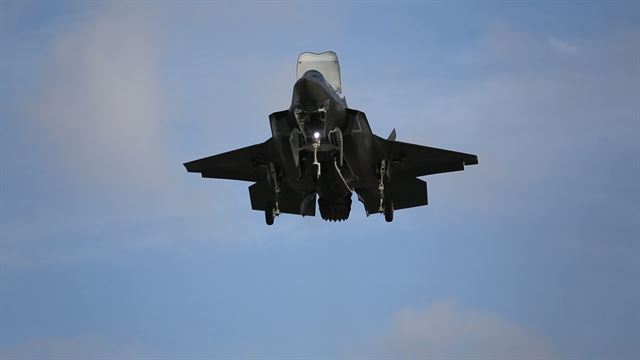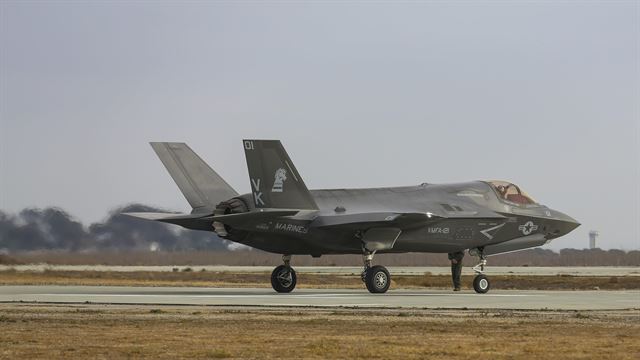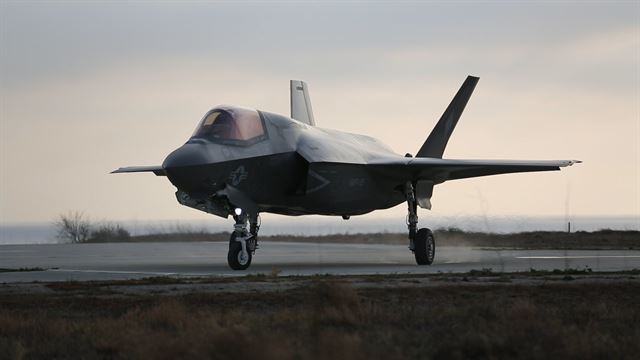2015-12-12 While the Air Combat Command is holding an exercise with F-22s, Typhoons and Rafales at Langley AFB to shape fifth generation warfare integration, the Marines are bringing fifth generation warfare capabilities to close air support.
F-35B Expeditionary from SldInfo.com on Vimeo.
During our visit to Denmark to participate in a unique airpower conference co-sponsered by our partners the Williams Foundation (Australia) and the Centre for Military Studies (Denmark), Lt. Col. “Chip” Berke brought the fifth generation Marine Corps perspective to the conference.
He argues for the need really to accelerate the leap into fifth generation-enabled combat forces for the US and its allies.
“When you look back a decade from now, what will the F-16 be in 2025? Or the F-18 in 2025?
The disparity which is already significant now will be even greater a decade out with comparison to the F-35.”
It is about the plane in an important sense.
We don’t want to find ourselves freaking out in 10 years that we wasted the last 10 years wondering, “Should we?” We should have spent all that time asking ourselves, “How do we?”
The “should we” question is yesterday’s news.
If you’re asking if we should fly Fifth Generation airplanes – if you’re asking if a Fifth Gen fleet is necessary, you are old.
You are behind.
You are late.
And you’re going to lose.
In another sense it is really about the synergy between the plane and the emerging fleet and the fifth-generation enabled combat ecosystem.
Berke used the iPhone analogy to describe the dynamics of change.
When Steve Jobs introduced the iPhone he said it was revolutionary for it combined a computer, with a music player with a phone.
And he repeated this several times in the roll out presentation.
I doubt that anyone in the audience today would describe their iPhone that way.
The ecosystem, which grew up around the phone and with which the phone itself has matured, is what is revolutionary, not simply the phone.
The same is true of the F-35; it is revolutionary; but the ecosystem which will change and which will inform the further development of the aircraft is even more so.
When we fast forward to 2025, what will be the threats with which we will be dealing?
Berke underscored that we could debate that point from the perspective of 2015 but it would be a debate.
Come 2025, and the threats will be much clearer and need to be dealt with.
We need a platform which can be responsive to those threats and evolve over time.
That is precisely what the F-35 is all about.
The F-35 is designed to evolve…..
Plasticity is about the idea that is inherent in the design, inherent in the DNA of the equipment you buy, is the ability to substitute for other elements as needed.
I understand that the F-35 is built as a tactical aircraft; I get that. The fact that it’s designed as well to be flexible to other mission sets and live in other regimes that you’d never ask a tactical platform to do is what give is it that inherent flexibility, that inherent plasticity.
Do we have a platform that’s flexible enough to adapt to that changing environment? Fourth generation airplanes simply can’t do that.
And in a theme that he introduced in the Canberra conference last year, Berke underscored that the notion of a tactical fighter was undergoing change as the pilot’s ability to operate in the battlespace with information capabilities, expands as well.
The burden that the F-35 places on a pilot is much greater, and I understand the information processing is better.
I understand that the pilot interface with the aircraft is a lot better, but the skill set is much broader now because that pilot and that aircraft interact on a much broader capability, and it’s much more operational, much more strategic, than any tactical platform that’s ever been built because it’s resident in the design of the airplane because of the things that it can do.
I can provide information to a general officer sitting in a CAOC.
At the exact same time, I can send information to an aircraft flying ten miles away from me.
That information is relevant to both at the same exact time in two totally different ways.
No other airplane has ever been asked to do that before, let alone have it be natural in its DNA or expect to be able to do that by design.
And to highlight the significant difference between the 4th and 5th generation, one simply can compare what was asked of each when they were launched into operation.
What makes a sensor-collaborator-shooter platform relevant?
That is not the question we asked about a fighter 10 years ago, 25 years ago.
That was not the question we asked in 1975 when we wanted to buy the F-16.
That’s not the question that was asked 10 years ago with the Typhoon.
Information development, access sharing, and the ability to integrate security – that’s how you measure the F-35.
That’s how you measure the fifth generation fleet.
How well does it do that?
You can build and design an airplane, and we have a designed and built airplane, to be able to answer those questions, to be relevant as a shooter, to be relevant as a collaborator.
You have this information.
I have this information.
Let’s view that information together, provide each other a much more enhanced picture to make a more intelligent decision while, at the same time, funnel information to other users that can parse out the data that’s valuable and relevant to them.
And it is the ability to operate throughout the combat spectrum that is essential as well, and is a core competence of the F-35.
Air warfare is about spectrum dominance.
It’s not just enough to say, “My radar is better than your radar,” or “My sensor is better than your sensor,” or “My capability in this spectrum is better than yours.”
I have to be able to move back and forth between spectrums.
I need to figure out where within the spectrum the fight’s going to take place, and then layer on top of it as much depth.
That’s what Sensor Fusion is by the way….
It isn’t just enough for that one airplane to get that information, it’s the data link and the multi-functioning capability that all these different airplanes are fusing information together behind the scenes, and handing it to you, so you can now make decisions based on information that another airplane 10 miles or 100 miles away have given you, that you didn’t even realize because you don’t even have to ask him for information because it’s just there.
And then Berke addressed the question of stealth and focused on its important contribution to the plane and its ability to operate and not providing a mystical capability.
Stealth facilitates access.
It doesn’t make you invisible; you don’t fly around with impunity.
It just allows you to operate in an environment that you could be restricted from or excluded from without it.
You take that with all the other capabilities of the platform, aggregate them together, and you now have a survivable platform that can operate in certain environments that no other platform can.
And clearly, the F-35 is designed to work with core assets throughout the battlespace.
With regard to other aircraft, the F-35 makes other aircraft more lethal and more survivable–and legacy airplanes provide ordinance and battlespace presence which complements the F-35 as well.
“Don’t just think that the presence of a fifth gen platform is good to the legacy airplanes.
It’s a two-way street, and it’s very functional for everybody.”
And he warned that if you do not make the jump into the F-35 world, you will have a core challenge of working with everyone else who has.
If you’re on the outside saying, “I have this asset that I’d like to contribute to your fight,” you put the onus on the recipient and go, “Well, we can use that on this side. Maybe it will fit here.
Can we communicate?
Can we make this work?
Can we make this relevant?
Let me see how you fit in.
For the USMC, the F-35 delivers essential capabilities to enhance the survivability and lethality of the MAGTF.
At the same time, it also allows the Marine Corps to link up more effectively with other forces as well.
Be brilliant for the Marines on the ground, keep Marines alive, support Marines in contact, and support Marine Corp objectives. We can operate any time, any place, anywhere, for any reason, with any other user.
Now you have a force that is relevant well beyond what its mission statement looks like on paper.
That’s what the F-35 provides for everybody.
It’s a great question to ask, what is it like to be part of that larger ecosystem?
In the Q and A, one audience member asked about the A-10 discussion in the US and Berke had a straightforward response:
As a JTAC the key requirement is that the airplane show up.
The A-10 pilots are amazing; the plane will not always able to show up in the environment in which we operate; the F-35 will.
That is the difference for a Marine on the ground.
What Lt. Col. Berke discussed in Copenhagen, the Marines are implementing in practice.
After declaring IOC for the F-35B, the Marines have moved on with the integration of the plane into Marine Corps operations.
In the video below, Marine Fighter Attack Squadron (VMFA) 121 is seen performin a refueling exercise with the F-35B Lightning II at Red Beach aboard Marine Corps Base Camp Pendleton, Calif., Dec. 11, 2015.
The refueling exercise was part of Steel Knight 16, a combined arms live-fire exercise which prepares 1st Marine Division for deployment as the ground element of a Marine Air-Ground Task Force.
F-35B in Steel Knight Exercise from SldInfo.com on Vimeo.
According to an article by Cpl. Alissa Schuning, Marine Corps Air Station Miramar, published on 12/11/15:
Marine Fighter Attack Squadron (VMFA) 121 conducted the F-35B Lightning II’s first-ever expeditionary test in support of exercise Steel Knight 16, Dec. 10, 2015.
Exercise Steel Knight is a combined arms live-fire exercise that implements a combination of air and ground assets to complete a wide range of military operations to prepare 1st Marine Division for deployment as the ground combat element of a Marine Air-Ground Task Force.
VMFA-121’s role in the exercise was to conduct close air support drills and expeditionary missions in support of the MAGTF.
During the exercise, the F-35 utilized the expeditionary airfield on Marine Corps Air Ground Combat Center Twentynine Palms, California, and the expeditionary landing pad at Red Beach on Marine Corps Base Camp Pendleton, California.
“We’ve done similar landings in [Marine Corps Air Station Yuma, Arizona], but the one at Red Beach was the smallest vertical landing pad we have used to date,” said Maj. Colin Newbold, the flight operations officer with VMFA-121.
Exercise Steel Knight allowed VMFA-121 the opportunity to illustrate the abilities of the F-35 to operate organically in an austere environment while helping accomplish the mission of the MAGTF.
“This is the first time that we get to truly test the capabilities of the aircraft in an expeditionary setting,” said Newbold, the flight operations officer with VMFA-121. “This is going to be a real learning experience for everyone involved and will prove helpful in the future when developing tactics.”
Credit Video: Marine Corps Air Station Miramar / 3rd Marine Aircraft Wing
12/10/15


